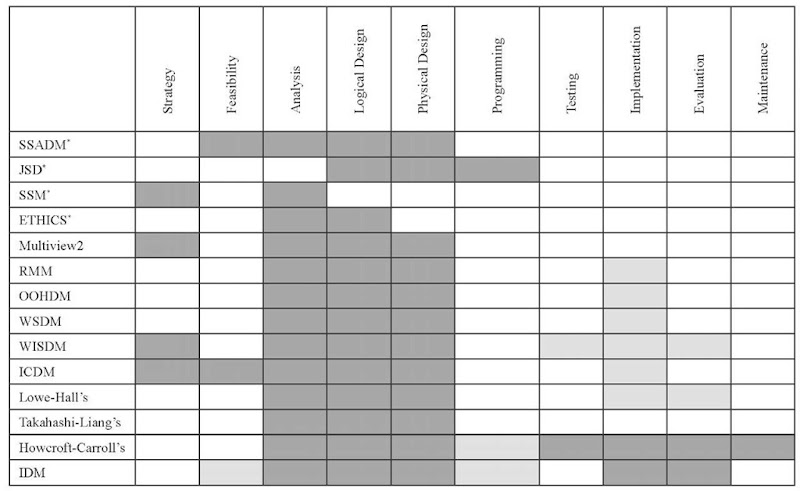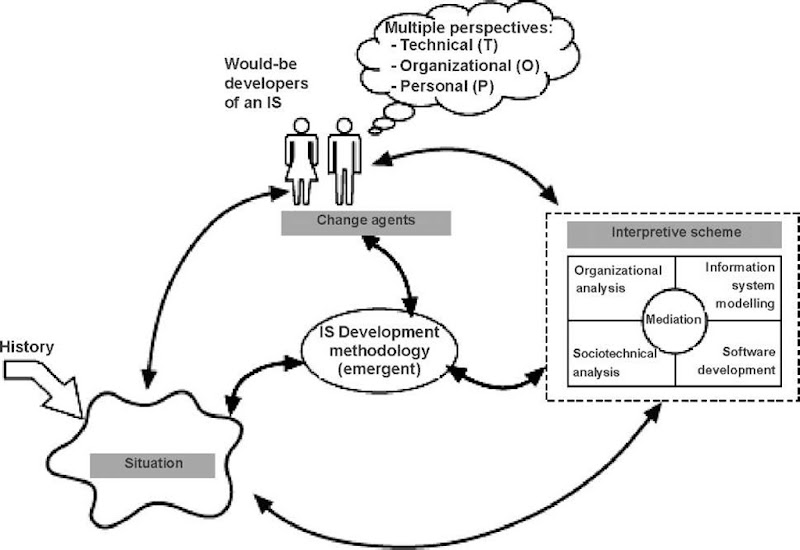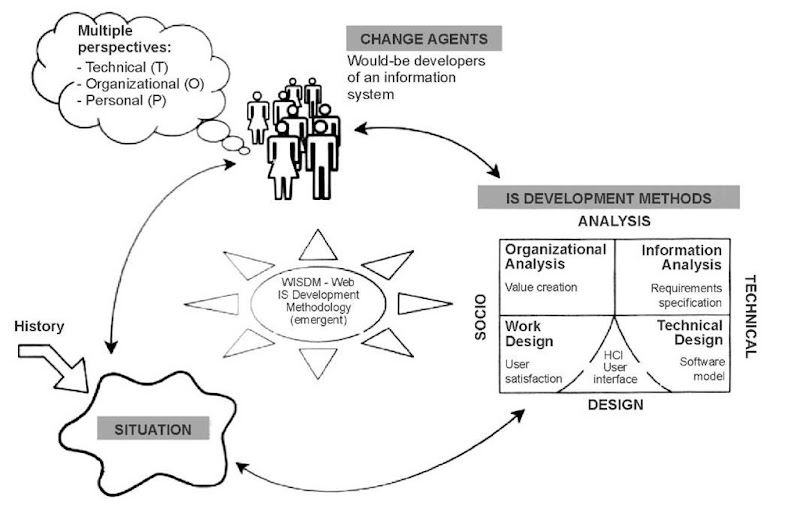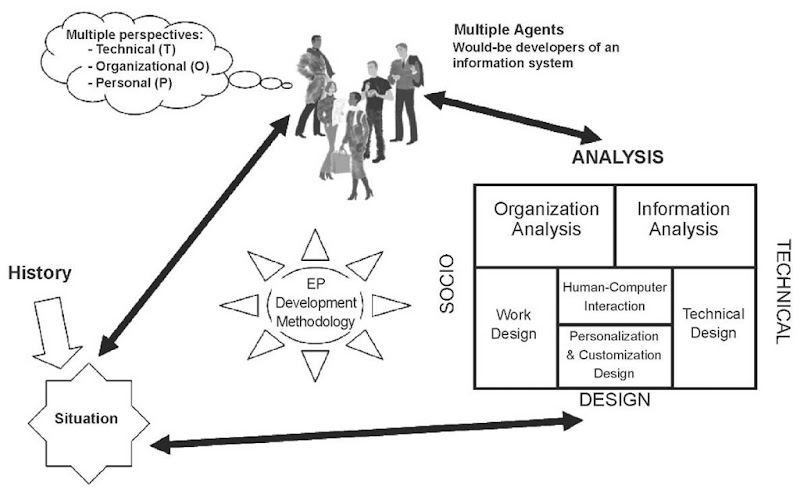INTRODUCTION
A major objective of this article is to propose a framework for development of a campus portal accommodating the end-users’ online activities, especially students who are normally considered as a major group of users for the campus portal. By summarising between the literature review in the domain of traditional information systems development methodology and Web-based information systems development methodology and the findings of the research, an appropriate model can finally be concluded and recommended, and is presented in this article. Although this article can be considered as a standalone article, it is recommended that the reader read the article entitled “The Need for a Comprehensive Methodology for Campus Portal Development.” Additionally, the complete version of this research can also be obtained from the digital thesis section of the University of Wollongong Library (http://www. library.uow.edu.au).
BACKGROUND ON THE FINDINGS
The results substantiated the claim made in the literature review of the portal technologies that the design and implementation of the personalisation and customisation functionalities could be a substantial factor that determines the appropriate approach to the development of the campus portal.
Based on the case study, the usage pattern of student’s online activities presents a clear picture of the design, development, and implementation issues of the personalisation and customisation functionality of a campus portal. On the other hand, some conflicts between the vision of the development team and the usage pattern of the students were detected which, may lead to the misunderstandings on the major concepts of the campus portal development.
In the design of the empirical study, there are three confounding variables (gender, student category, and educational level) that could influence the usage pattern of the student’s online activities when using the survey questionnaire as an instrument.
A SELECTION OF THE DEVELOPMENT METHODOLOGY FOR A CAMPUS PORTAL
This research places its emphasis on the methodology for in-house development of a campus portal. The research approach will start by analysing the available information systems and Web development methodologies to find those existing development methodologies that are appropriate to the development of the campus portal. The traditional development methodologies which were studied in this research are system development life cycle (SDLC), structured systems analysis and design method (SSADM), Jackson system development (JSD), soft system methodology (SSM), effective technical and human implementation of computer-based systems (ETHICS), and multiview. Additionally, many studied Web-based information systems development methodologies are relationship management methodology (RMM), object-oriented hypertext design method (OOHDM), Web information systems development methodology (WISDM), Web site design method (WSDM), Internet commerce development methodology (ICDM), Lowe-Hall’s hypermedia and Web engineering approach, Takahashi-Liang’s Web-based information systems analysis and design, Howcroft-Carroll’s methodology for Web development, and intranet design methodology (IDM).
criteria for the selection
Adapting the criteria of Murugesan, Deshpande, Hansen, and Ginige (1999) to the campus portal development, the selection of the development methodology should match the following criteria, taking into account the special characteristics of campus portals.
Multidimensionality
Previous research shows that factors influential in major failures of development projects are lack of commitment in top management and inadequate user involvement (Keil, Cule, Lyytinen, & Schmidt, 1998; Wallace & Keil, 2004). To satisfy user needs, a system must be developed accordingly and fulfill the requirement of the users (Standing, 2002). Campus portal users are composed of many groups of stakeholders that require different needs and may have a direct or indirect relationship to each other (Pressman, 2005). Each group also performs different activities to facilitate and achieve their objectives. The development methodology, therefore, should consider the development of a campus portal with a user focus from the multiple views of stakeholders.
Flexibility
Inflexibility in the development methodology inevitably leads to problems (Avison & Fitzgerald, 2002, 2003a). A campus portal is a complex project, integrated with many Web-based information systems and other online services. Consequently, the development methodology should be flexible enough to allow the developers to adjust methods, tools, and techniques, as well as the process of the development to suit the local situation.
Supporting Critical Characteristics of the Campus Portal
As shown in the earlier phases of this research, the development methodology has to support the functions of personalisation and customisation, which have been mentioned previously as critical characteristics that define a third or fourth generation of campus portal. In the field of human-computer interaction (HCI), however, good usability is widely accepted as a critical component for Web sites and Web applications (Vidgen, 2002; Vidgen, Avison, Wood, & Wood-Harper, 2002). The development methodology for a campus portal should also consider usability as an additional critical characteristic.
Comparison of Existing Development Methodologies
Avison and Fitzgerald (2003a, pp. 555-572) provide a framework for comparing methodologies in the final article of their topic. They mentioned that “comparing methodologies is a very difficult task, and the results of any such work are likely to be criticised on many counts. There are as many views as there are writers on methodologies. The views of analysts do not necessarily coincide with users, and those views are often at variance with those of the methodology authors” (Avison & Fitzgerald, 2003a, pp. 555-572).
They also mention that a number of additional elements might be appended to the framework in order to compare methodologies for a particular purpose. As most traditional information systems methodologies have been referred to by Avison and Fitzgerald (2003a), this research will also adopt their approach in order to explain the traditional development methodologies. This will be extended to Web development methodologies in this research.
Because of the wide range of differences between the traditional information systems development methodologies and Web-based development methodologies, Avison and Fitzgerald (2003a), point out that this research will customise and use only some elements of their framework for comparing development methodologies against the campus portal’s criteria, as described in the previous section. This comparison will concentrate on positive aspects, rather than on the disadvantages or pitfalls of all possible development methodologies in order to select and justify the most appropriate development methodology for the campus portal, based on the defined criteria.
Philosophy
The general philosophy of all information systems and Web development methodologies is to improve the areas of development in each respective world. An in-depth philosophy of each development methodology, however, varies and depends on many factors such as paradigm, objectives, domains, and targets (Avison & Fitzgerald, 2003a).
Paradigm
Among the traditional information systems development methodologies, SSM, ETHICS, and Multiview2 are categorised into system paradigms and SDLC, SSADM, and JSD belong to the science paradigm. The reason is that SSM, ETHICS, and Multiview2 provide a perspective for both technical and social perspectives, whereas the others emphasize the technical perspective of the information systems development.
Although Multiview2 is claimed as a framework by the authors of the development methodology (Avison & Fitzgerald, 2003a; Avison, Wood-Harper, Vidgen, & Wood, 1998), there is much confusion in specifying the exact type of Multiview2, because it can be referred to as an approach, a methodology, a framework, or metaphor (Zhu, 2002). This research views Multiview2 comparable as a development methodology for developing an information systems.
Among Web-based system development methodologies, only WISDM and ICDM can be categorised into a system paradigm, whereas RMM, OOHDM, WSDM, Lowe-Hall’s Approach, Takahashi-Liang’s method, Howcroft-Carroll’s methodology, and IDM belong to the science paradigm.
Objective
Among the traditional information systems development methodologies, SDLC, SSADM, JSD, and Multiview2 can be categorised as the development methodology for building the system. However, there is not a clear and distinct answer regarding whether or not SSM and ETHICS can be viewed as improving the system, because the processes recommended in the development methodologies also can be considered as a category for building the system, which was proposed in different a approach. Multiview2 framework and JSD, however, does not cover all stages found in SDLC and SSADM. More information on the scope of the development methodology will be further discussed in a later section.
Among Web-based system development methodologies, all development methodologies, that is, RMM, OOHDM, WSDM, Lowe-Hall’s Approach, Takahashi-Liang’s method, Howcroft-Carroll’s methodology, IDM, WISDM, and ICDM, are considered as building the system category.
Domain
Among the traditional information systems development methodologies, SSM is more unique than other methodologies. Regarding the comments made by Avison and Fitzgerald (2003a), SSM can be categorised as the methodology for planning, organisation, and strategy type, where as SDLC, SSADM, JSD, and ETHICS can be classified as specific problem-solving methodologies because they specify a particular problem. In addition to the methodology for planning, organisation, and strategy, Mutiview2 framework can also be identified in this group because it focuses on a wider aspect of problem-solving in both the technical issue and organisation.
Among Web-based system development methodologies, RMM, OOHDM, WSDM, Lowe-Hall’sApproach, Takahashi-Liang’s method, Howcroft-Carroll’s methodology, and IDM are categorised as specific problem-solving methodologies. In contrast, WISDM and ICDM are more than problem-solving methodologies because they provide a planning procedure from both organisation and technical perspectives. However, ICDM pays little attention to explaining the details of the user interface design, although they are concerned that it is a very important part of the development of a Web-based system, whereas WISDM identifies the user interface (human-computer interface) as a designing stage.
Target
It is a very difficult task to identify the various targets of the development methodology because most methodologies claim to be used for a general purpose (Avison & Fitzgerald, 2003a). Avison and Fitzgerald (2003a) mentioned that the size of an organisation, which methodology addresses is an important aspect for comparison. This research will additionally focus on the size of the project to increase the dimension of the comparison of the methodologies.
Among the traditional information systems development methodologies, most methodologies can handle from small to large size projects because they are designed to support large organisations that have a capability to afford the development and implementation cost of an information system in a booming period of computer-based information systems. Multiview2 is a framework that was just being introduced to the information systems area in the late 1990s, which the size of most organisations where information systems development is still being active are small and medium enterprises. This makes Multiview2 designed to support small organisations (Avison & Fitzgerald, 2003a).
Previously, most hypermedia development methodologies, that is, RMM and OOHDM, could be adopted for supporting small to medium sized Web projects. Recently, the authors of these methodologies claimed that they could support the large and complex projects because the methodologies have been enhanced. Additionally, WISDM and ICDM can be adopted to use in medium and large projects regardless of the multiple perspectives that allow developers to understand the situation of the project, people, and organisation. However, the approach to the WISDM and ICDM view is quite different when compared to the majority of the development methodologies, which only focus on system building.
Scope
In the framework of Avison and Fitzgerald (2003a), there are a number of stages which are taken from the conventional set of the development life cycle. There are strategy, feasibility, analysis, logical design, physical design, programming, testing, implementation, evaluation, and maintenance.
The purpose of displaying Table 1 is to provide an overview for the focus area of the methodologies. Dark grey represents the main emphasis area of the methodology, and light grey represents the attempting area, which was mentioned in the methodology but somehow may not be fully explained. This approach is uncomplicated to understand because most current developers are already familiar with the steps of the life cycle approach. In contrast, it may misrepresent some methodologies which are not designed to follow the traditional structure of the life cycle system (Avison & Fitzgerald, 2003a).
Filtering the Development Methodologies through the Criteria
Multidimensionality
As it was previously discussed, most traditional information systems and Web-based development methodologies view problems as a one dimensional perspective, which attempts to solve the specific problems. On the other hand, SSM, Multiview2, WISDM, and ICDM address not only the technical perspective, but also include some wider aspects on the organisation and people perspective (Linden & Cybulski, 2004).
Table 1.
Flexibility
Although some methodologies, such as IDM and ICDM, provide a feedback loop that allow the developers to go back to the previous stages. It, however, allows to go back to only a certain stage of the development.
Multiview2 and WISDM are different to other methodologies in this term because there are no step-by-step stages to be followed. This makes these methodologies more flexible than the others. However, it might not be suitable for inexperienced developers, who may need a procedure of the development to follow.
In addition to flexibility, Takahashi-Liang’s methodology recommends some tools, namely, WebArchitect and PilotBoat, which are rarely recognised by developers. This approach drives a methodology to its limits.
Supporting Critical Characteristics of the Campus Portal
The personalisation and customisation, together with the user interface issue, were identified as major critical characteristics of a campus portal. The methodology needs to support these characteristics in order to develop an effective and efficient campus portal.
One critical missing component of most traditional development methodologies is the user interface issue, which is critical to Web-based system development. The literature shows that most methodologies were designed for traditional information systems development, which has already been recognised here to be different from that of Web-based systems, particularly in the area of usability. Most traditional development methodologies therefore do not fully support the interactive themes and characteristics of a Web-based system (Howcroft & Carroll, 2000; Powell, Jones, & Cutts, 1998).
On the other hand, the user-interface issue is a major focus of many Web-based development methodologies. Summarised from the literature, there are three major themes of Web-based development that can be identified: Web site, Web application, and Web information systems.
Some methodologies such as RMM and OOHDM originated from hypermedia development, in particular RMM and OOHDM were enhanced to more accurately support the development of a Web-based system (see Isakowitz, Kamis, & Koufaris, 1998; Isakowitz, Stohr, & Balasubra-manian, 1995).
Regarding these themes, it can be summarised that RMM, OOHDM, WSDM, Lowe-Hall’s Approach, Takahashi-Liang’s Method, Howcroft-Carroll’s Methodology, and IDM are more appropriate to Web site development, whereas WISDM and ICDM are more suitable for Web application and Web information systems development.
SELECTED DEVELOPMENT METHODOLOGY FOR CAMPUS PORTAL PROJECTS
It can be concluded from the discussion and analysis above that there are no supporting models that clearly focus on personalisation and customisation, whichaie the most critical and unique characteristics of the campus portal. Undoubtedly, most traditional development methodologies were developed before the Internet became popular. However, most Web development methodologies focused on the personalisation and customisation issues, except perhaps OOHDM, which talks about the personalisation issue (see Rossi, Schwabe, & Guimaraes, 2001).
It is deduced from the analysis here that most traditional information systems development methodologies fail to address critical aspects of Web-based system development, especially user interface issues, whereas most Web-based development methodologies, including OOHDM, fail to address the aspects of the organisation and people issues in order to develop effective complex Web applications and Web information systems for the organisation. Although the method of OODHM for handling the personalisation issue is deemed useful, OODHM is more appropriate to the development of Web-based applications than Web-based information systems that need to integrate the multiple dimensions of the organisation and people issues.
Based on this analysis, it appears that the most appropriate methodologies for the development of a campus portal are: Multiview2, WISDM, and ICDM. All of these methodologies have the potential to be adapted and adopted for the development of a campus portal. However, none of these development methodologies offers the ability for inclusion at the design stage, or the functionality of personalisation and customisation.
In the case of the development in a campus portal project, a stage for the design of the personalisation and customisation characteristics needs to be appended into the development methodology. This highlights to all members of the development team that they need to critically consider the issue of personalisation and customisation throughout the development, and include this functionality in the basic design of the portal. Moreover, they need to make sure that at the implemented level the personalisation and customisation continues to support the current usage pattern of the end-users’ online activities throughout the life of the portal.
In summary, a major contribution of this research is the recommendation that a suitable campus portal development methodology be based on Multiview2, ICDM, and WISDM. An overview of each is as follows:
• Although a Multiview2 framework is a new methodology which offers great flexibility to the information systems development, it, however, does not address well the user interface issues that are a critical component of the Web-based information systems and campus portal.
• ICDM provides multiple perspectives to Web-based development; however, a weak stance on user interface design is found in this methodology. Additionally, its step-by-step approach makes it somewhat inflexible for experienced developers.
• WISDM (see Figure 2) presents a clear consideration of user interface issues because the user interface issue under the heading “human-computer interface” is presented as a major component of the methodology. Additionally, the methodology adopts the Multiview2 style of framework (see Figure 1), which does not offer a step-by-step approach to the process of development and so is more flexible than the other methodologies. However, experienced developers are needed in order to manage and develop the Web-based information systems using this methodology because of this.
In this important section of the article, the result of the selection process for the proposed development methodology particularly suitable for the campus portal projects has been presented, discussed, and justified. Through the comparison between traditional information systems and Web-based system development methodologies and by applying criteria identified as particularly appropriate to the characteristics of campus portals, it has been concluded that WISDM is the most appropriate methodology that can be developed into the methodology for the campus portal. However, a modification of WISDM is needed in order to support the critical criteria of the campus portal, as will be shown in the following section.
A PROPOSED DEVELOPMENT METHODOLOGY FOR CAMPUS PORTAL
Using the findings and critical analysis of the research, WISDM was selected as the basic framework, and extended with the concepts of personalisation and customisation, which have been incorporated within the design element of the framework to create the specialised campus portal Development Methodology (CPDM) (as shown in Figure 3). WISDM, created by Vidgen (2002) and Vidgen et al. (2002) was itself extended from the Multiview2 framework by Avison et al. (1998). Although this may seem to be a minor change to the WISDM framework, it is interpreted and asserted from the results of this study that consideration of personalisation and customisation issues is critical to the development of a campus portal in the same way Human-Computer Interaction is.
Figure 1. Multiview2
Figure 2. WISDM
Figure 3. A campus portal development methodology (CPDM)
With the CPDM, the development team should be able to develop a campus portal that suits the particular concepts and critical characteristics of campus portals. As can be noticed from the CPDM shown in Figure 3, the Personalisation and Customisation Design element is recommended as separated from that of Human-Computer Interaction, which focuses on the design of the user interface. In addition, the CPDM has changed slightly; the name of this element, from human-computer interface to human-computer interaction (HCI), which provides a broader perspective in terms of the users’ activities. This is in line with the findings of the case study.
In this approach, the CPDM framework should be able to direct the development team to perform these compulsory design stages. They should thereby be able to eliminate the problems that were revealed in the case study regarding the vision of the development team on the campus portal.
FUTURE RESEARCH DIRECTIONS
As previously mentioned, there are many areas related to development methodology research (Nunamaker Jr., Chen & Purdin, 1991, Wynekoop & Russo, 1997), and so future research on this topic can be extended in many directions. Firstly, the CPDM definitely needs further testing, validating, and refinement before it can be of significant benefit to development teams and academic researchers. Action research may be implemented for testing the CPDM in an actual situation as it is commonly used to develop and test development methodologies (see Avison & Wood-Harper, 1986; Avison & Wood-Harper, 1990; Avison et al., 1996; Vidgen, 2002; Vidgen et al. 2002). Secondly, the study on the other groups of end-users in other countries is suggested in order to validate and make the results more reliable. Thirdly, the end-users’ satisfaction and performance after the adoption of the CPDM would also be a very interesting area of study.
It is hoped that the significant contributions of this research to the relevant body of knowledge will benefit other information systems and system development researchers and, most importantly, the practitioners.
KEY TERMS
Campus Portal Development Methodology: A framework or systematic approach that allows a group of development team to be able to anticipate and follow an appropriate development structured pathway to optimise the construction of the computer-based information systems which may be based on Internet-based computer system and architecture. However, the major focus is to have more concentration on the personalisation and customisation.
Information System Development Methodology: A framework or systematic approach that allows a group of development teams to be able to anticipate and follow an appropriate development structured pathway to optimise the construction of the computer-based information systems which may be based on traditional computer system and architecture.
Web-Based Information System Development Methodology: A framework or systematic approach that allows a group of development teams to be able to anticipate and follow an appropriate development structured pathway to optimise the construction of the computer-based information systems which may be based on Internet-based computer system and architecture.




